Teacher Pages
Teacher
Pages
|

|
Motors and
Meters
|
California
State Standards addresed
Grade
four
Physical
Sciences
Sub Sections:
1.
Electricity and magnetism are related effects that have many
useful applications in everyday life. As a basis for
understanding this concept:
c. Students
know electric currents produce magnetic fields and know how
to build a simple electromagnet.
d. Students
know the role of electromagnets in the construction of
electric motors, electric generators, and simple devices,
such as doorbells and earphones.
f. Students
know that magnets have two poles (north and south) and that
like poles repel each other while unlike poles attract each
other.
|
Grade
Nine - Twelve:
Electric and Magnetic Phenomena
Sub Sections:
Electric and Magnetic Phenomena
5. Electric and magnetic phenomena are
related and have many practical applications.
e. Students know charged particles are
sources of electric fields and are subject to the forces of
the electric fields from other charges.
f. Students know magnetic materials
and electric currents (moving electric charges) are sources
of magnetic fields and are subject to forces arising from
the magnetic fields of other sources.
g. Students know how to determine the
direction of a magnetic field produced by a current flowing
in a straight wire or in a coil.
h. Students know changing magnetic
fields produce electric fields, thereby inducing currents in
nearby conductors.
j.* Students know electric and
magnetic fields contain energy and act as vector force
fields.
|
|
|
|
Motors and Meters
When tiny, negatively charged particles called
electrons flow through a wire, you have an electric current. When you
bring an electric current and a magnet together, interesting things
can happen. A magnet creates an invisible magnetic field that pushes
against an electric current. What's more, the moving electrons also
create a magnetic field that can interact with other magnets that are
nearby. This interaction of magnets and moving electrons is what
motors and meters are all about.
At each exhibit on this Pathway, try to find
the permanent magnets and the path (or circuit) that the electrons
follow. If you have any questions or problems, ask an orange-jacketed
Explainer for help.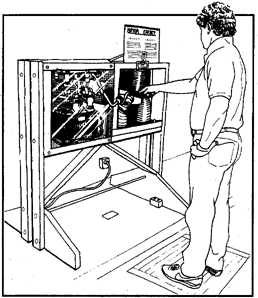
Motor Effect
Associated
Snack
Motor
Effect
Step on the floor mat to send an electric
current through the thick black wire. Watch the wire fly up in the
air. Try to push it down. You may be surprised at how hard the green
and red magnets force the wire upward.
Daisy Dyno
Hold the tip of the wire right at the edge of
the metal disk, beneath the magnet. Does the disk spin?
__yes or __no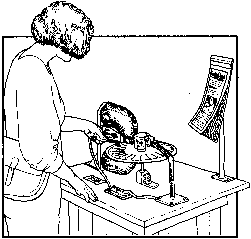
Hold the tip of the wire at the edge of the
disk on a daisy petal that doesn't run beneath the magnet. Does the
disk spin?
__yes or __no
When you hold the wire at the edge of the disk,
electrons flow along the daisy's petals, from the edge to the center
of the daisy. When you hold the wire so that the electrons flow
beneath the permanent magnet, the magnetic field pushes against the
moving electrons, making the disk spin.
Stripped-Down Motor
Associated
Snack
Stripped
Down Motor
Turn the switch to the right of the battery so
that it makes a connection between the two copper bumps. Watch the
copper wires spin.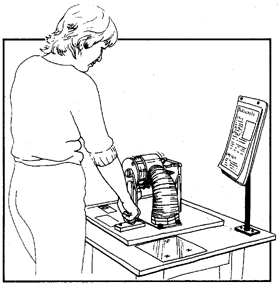
Electrons flow from the negative side of the
battery, through the motor, and then to the positive side of the
battery Trace the path of the moving electrons with your finger,
starting at the negative side of the battery and following the wire
up to the copper plate.
The copper plate is divided into four sections.
Each section connects to one end of a thick loop of wire. The other
end of the loop is attached to a different section of the copper
plate. The electrons flow into the copper plate, through the loop,
back to the copper plate, down a wire, and through the switch to the
positive side of the battery. The magnet pushes on the moving
electrons that flow through the loop of wire, making the motor
spin.
Giant Meter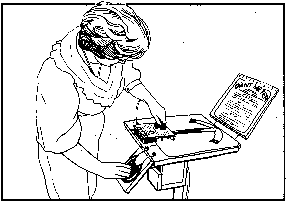
This Giant Meter uses a coil of copper wire and
a magnetized needle to measure the flow of electricity~ Turn the knob
to make electrons flow through the coil of wire. The moving electrons
make the coil of wire into a magnet. This magnet, in turn, makes the
iron bar into a magnet, which pushes the magnetized meter needle to
one side.
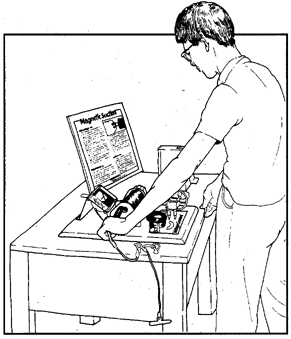
Magnetic Suction
Associated
Snack
Magnetic
Suction
Plug in the yellow plug and turn the voltage
all the way up. Put the iron bar into the mouth of the coil and feel
the magnetic force pull the bar in.
Unplug the yellow plug. Is there any magnetic
force now? __yes __no
Pull out the plug, reverse it, and plug it in
again. What happens?
____________________________________________________
Try to find a coil and an iron rod in the doorbell and in the pinball
flipper.





